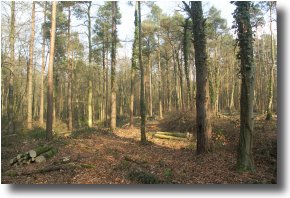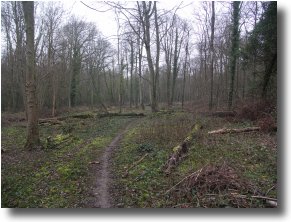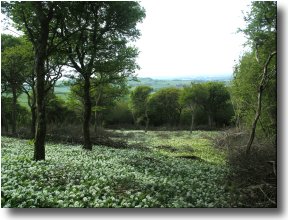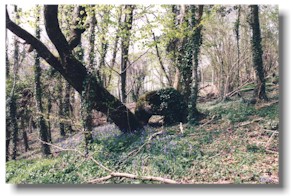Wight Conservation - Woodland Management
Wight Conservation's Woodlands
Apart from the large Brighstone Forestry Complex on long term lease to the
Forestry Commission, we have seven separate woodlands in-hand, totaling 265 acres.
They have been gradually acquired since 1990.
The woodlands are all broadleaved in character, although with the exception of Wroxall and Rew Copses, there have been limited conifer plantings over the last 60 years.
Wroxall and Rew Copses are entirely Ancient Woodland sites, while four of the others
have important Ancient Woodland elements.
Despite a few indicators and the presence of wych elm, there are no records for
the origin of Coombe Plantation, and the wood does not appear in any of the
older maps. Wroxall Copse and Rowborough, both of which are important for their
veteran trees, were obviously wood-pasture and sheep grazed until WWII. The
Brighstone Forestry complex, on a 999 year let to the Forestry Commission, is
all less than 80 years old.
Wight Conservation Management
 Woods need management, otherwise they quickly deteriorate and become largely
barren of many forms of wildlife. At purchase, our woods had all severely
suffered from the 1987 storm and lack of management. Many rides were blocked and
impenetrable, and the canopies had closed over, cutting out most of the sunlight.
There was a dearth of birds and butterflies. The shade severely suppressing
much of the valuable vegetation. Few hazel stools bore nuts and hence there was
a shortage of an invaluable food source for both the red squirrel and the
dormouse. Woods need management, otherwise they quickly deteriorate and become largely
barren of many forms of wildlife. At purchase, our woods had all severely
suffered from the 1987 storm and lack of management. Many rides were blocked and
impenetrable, and the canopies had closed over, cutting out most of the sunlight.
There was a dearth of birds and butterflies. The shade severely suppressing
much of the valuable vegetation. Few hazel stools bore nuts and hence there was
a shortage of an invaluable food source for both the red squirrel and the
dormouse.
Now, after several years of conservation-led management, and with the assistance
of Forest Enterprise grants, there has been a transformation. The woods
are increasingly open to sunlight and there has been a welcome resurgence of
woodland flora, including many Ancient Woodland indicators. Silence has been
replaced by bird song, and the hazel is fruiting. Butterflies are returning.
Due to their importance for veteran trees and wild flora, in 2008 Natural England accepted Wroxall and Rew Copses under our new Higher Level Scheme, thereby increasing funds for maintenance and badly needed capital works.
It is, however, a continuing and unrelenting process and it will be at least
another decade until the full benefits become apparent. In the meantime, we
believe that for its size our woodland estate is the most actively managed for
conservation in the south of England.
Rides
 Our core philosophy is to let in more sunlight, - then everything benefits.
Existing rides have been widened and scalloped to increase valuable woodland
edges. Ideally a ride width should be 1.5 times the height of adjacent trees,
but this is not always possible. Our main rides have all been widened, given
shape and lead on to the occasional glade. There are regular over-head pinch
points for the red squirrel and the dormouse to travel over. Our core philosophy is to let in more sunlight, - then everything benefits.
Existing rides have been widened and scalloped to increase valuable woodland
edges. Ideally a ride width should be 1.5 times the height of adjacent trees,
but this is not always possible. Our main rides have all been widened, given
shape and lead on to the occasional glade. There are regular over-head pinch
points for the red squirrel and the dormouse to travel over.
New Rides
Several kilometres of new rides have been created largely for timber
extraction or hunt passage purposes. Some are narrower and often damper than the
older ones, but all rides bring benefits to wildlife, regardless of whether they
are dry or wet, narrow or wide.
Ride Management
There is vigorous summer vegetation growth in the damp main rides. Hence they
have to be mowed up to three times a year instead of the usual once, otherwise
the tall growth would completely deprive the shorter species of badly needed
light. Furthermore, with improved woodland edges providing it with more
foraging, the red squirrel enjoys the security of small open spaces allowing it
to quickly detect and evade any predator.
Increasingly our main rides are managed on a two or three tier system. The
central strip is regularly mown. The second tier, bordering the centre,
consisting of tall grasses and herbs, is cut on a two year rotational basis, and
the scrub third tier, (the outer edges) every three to five years.
Thinning and Skylighting
We
clean out the spindly, weak and poorly formed trees and remove
a proportion of trees to afford more growing space to those retained. About 25%
of the stems are thinned each visit. It results in a quality improvement in the
remaining stands, permitting their canopies to develop, and allows more sunlight
into the lower forest to benefit the under storey, particularly hazel, and the
ground vegetation. By this method, we should also be able to encourage natural
regeneration and avoid both clear felling and replanting.
Skylighting is similar to thinning except we are clearing around the finer
specimen trees, giving them more space and light for development.
Harvesting Operations
We take great care as to how the operations are carried out. We appoint
contractors for their sympathetic understanding of woodlands. Chosen thinning
seasons reduce disturbance to the wood’s ecology. Care is taken not to cut down
trees containing red squirrel drays (nests) and not to remove conifers
used as squirrel food sources. Care is also taken to avoid soil compaction and
rutting. No timber is extracted until soil conditions permit and much is left in situ
to rot as dead wood.
Coppicing
 Hazel coppicing is carried out in rotation. It involves cutting wood to
ground level and allowing it to reproduce itself by the shoots growing up from
the stumps (stools). We coppice hazel on a chequer board basis in areas of half
to one acre. There is no ready Island market to accept the better five/seven
years’ growth, and there is a growing shortage of coppicing skills. Hence our
policy is to rotate at 15-18 instead of 5-7 years. Although less beneficial for the ground
flora, birds and invertebrates, it is more helpful to the red squirrel and
dormouse, providing good shelter and an improving food source. It is then cut
for fire wood. A local hurdle-maker is allowed to "shave" off some of the
suitable sticks from the maturing coppice. Hazel coppicing is carried out in rotation. It involves cutting wood to
ground level and allowing it to reproduce itself by the shoots growing up from
the stumps (stools). We coppice hazel on a chequer board basis in areas of half
to one acre. There is no ready Island market to accept the better five/seven
years’ growth, and there is a growing shortage of coppicing skills. Hence our
policy is to rotate at 15-18 instead of 5-7 years. Although less beneficial for the ground
flora, birds and invertebrates, it is more helpful to the red squirrel and
dormouse, providing good shelter and an improving food source. It is then cut
for fire wood. A local hurdle-maker is allowed to "shave" off some of the
suitable sticks from the maturing coppice.
Dead Wood and Brash
Timber not used for firewood or processing is left as lying dead wood,
naturally breaking up with time. If practical, fallen veteran trees are left
lying whole. Dead wood is an important part of conservation management, because
it provides good habitats for a whole assemblage of invertebrates, mosses and
fungi. It is also visually attractive.
If trees die standing, then unless there are safety reasons. They deteriorate as dead wood, giving homes to birds and bats.
There is no burning in our woodlands. Brash (i.e. small branches and twigs) is
gathered up and rowed into "dead hedges". These might be several feet high and
again provide habitats for small woodland mammals, invertebrates and fungi,
whilst keeping the browsing mammals away from the new shoots.
Veteran Trees
 Veteran trees are a special feature of England’s woodlands, hedges and parks.
They are important for biodiversity and add much to the landscape’s visual
appeal. They are generally defined as trees in ancient stages of their
life, and trees that are old relative to others of the same species. Veteran trees are a special feature of England’s woodlands, hedges and parks.
They are important for biodiversity and add much to the landscape’s visual
appeal. They are generally defined as trees in ancient stages of their
life, and trees that are old relative to others of the same species.
Two of Wight Conservation’s woodlands are important for veteran trees and some
150 exist. They are principally ash, field maple and crab apple.
Proper management of veteran trees is important to Wight Conservation, as is
identifying trees that might become potential veterans in future centuries. For
more on the management and importance of veteran trees
click here..
Isle of Wight’s woodlands benefit from the absence of grey squirrels and
deer, which, through browsing, could cause immense damage to the country’s woods and
the form of individual trees.
Certification
UKWAS (The UK Woodland Assurance Standard) has been introduced in the last
decade. It is a voluntary scheme, largely motivated by some of the bigger stores
and some conservationists. It is a wide ranging qualification, subject to
audits by independent certification bodies. It embraces silviculture management,
planning, conservation, Health & Safety, access, use to the community, community
involvement, Trades Union membership etc. It is an expensive process and largely
irrelevant to the small woodland owner who finds that its annual cost might well
exceed his woodland income. The “carrot” offered by the large stores, such as
B&Q, is that they will only buy timber from certified woods. Wight Conservation
has decided not to participate but instead formally follows the
principles of good silviculture, conservation and Health & Safety.
Access
Wroxall Copse can be seen from two bridle paths - one going up a steep hill from north-south through the middle of the wood and the other west-east near the top side. They are particularly attractive when the wild flowers are out in late April and May.
At Rowborough, the shooting rights retained by Wight Conservation’s landlord
limit our scope to allow access. In our other managed woods, there is only
access on an organised or individual permission basis. We believe it is
important to leave the woods as quiet as possible to allow the wildlife to
flourish. Our own visits are restricted to management purposes and no dogs,
except on leads, are allowed. We are managing for wildlife, not people. CLICK for walk details.
Woodland Biodiversity
In 2000, Jonathan Cox, a well known freelance ecologist and nature
conservation adviser, author of several English Nature publications and
consultant to the The People’s Trust for Endangered Species at Briddlesford,
gave talk on "Priorities for Woodland Biodiversity on the Isle of Wight" to the
Isle of Wight Woodland Forum. It was later published by the Isle of Wight Farm
and Woodland Conservation Trust.
CLICK HERE for a brief history of woodland
evolution and development, with special reference to Wight Conservation's own
woods.
|